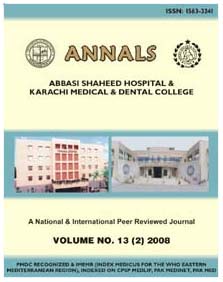
| |
| Home |
| Editorial Staff |
| Instruction to Authors |
| Journal-Issues |
| Policy |
| Copyright |
| VARIOUS METHODS TO DETECT HELICOBACTER PYLORI AND THEIR RESPECTIVE YIELD
ABU TALIB, MASHALLAH SHUJAI, KHALID MAHMOOD, ABU NOEM FAROOQUI, GHULAM MUSTUFA ABSTRACT Objective: This is a prospective study carried out in 100 cases with the aim to see various methods available to detect H. pylori and their respective yield. Further to select which of the two methods if combined together give the best/highest yield. Place of Study: Department of Medicine Dow University of Health Sciences (DUHS) & Civil Hospital, Karachi. Methodology: In this study 100 patients were selected coming to Gastrointestinal Clinic of Medical Unit - 5, Civil Hospital & DUHS, Karachi, for various dyspeptic symptoms and were suspected to be suffering from acid peptic disease. Multiple biopsy specimens (six) were taken for the study:-First two samples were directly inoculated into culture media. The third specimen was immerse directly into the helicourease gel for detection of H.pylori.The three biopsy specimens were preserved in the formalin for histological examination & for special staining to detect H.pylori. Finally 10cc blood was drawn to detect both quantitative & qualitative antibody titer for H.pylori. Result: All the tests for detection of H.pylori were performed on these 100 patients and it was found that Enzyme Linked Immunosorbent Assay (ELISA) 82% (Quantitative), H. Flex 72% (Qualitative) , Histology 66% , Helicourease test 52% , Culture 46% and ELISA & Histology combine74% positivity. Conclusion: Serological detection on IgG antibodies to H.pylori is found to be highly reliable for the diagnosis of H.pylori infection, because of its non-invasiveness, easy & quick to perform its reliability had made it to replace the invasive procedure as a primary diagnostic test. It is observed that if ELISA & histology are combined together give the highest yield, as histology is the most confirmative procedure to identify the active invasion of the organism into the substance of tissue.
|
For Full text contact to: |
